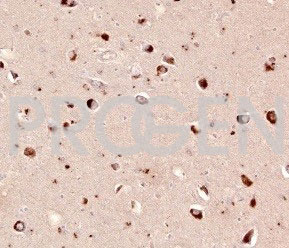anti-CD13 mouse monoclonal, EBS-CD-012, purified
- Mouse monoclonal
- Suitable for FACS, ICC/IF, IHC and WB
- Reacts with human
- Isotype: IgG1 kappa
Product description
| Quantity | 1 ml (100 µg/ml) |
|---|---|
| Antibody Type | Monoclonal |
| Host | Mouse |
| Isotype | IgG1 kappa |
| Conjugate | Unconjugated |
| Application | FACS, ICC/IF, IHC, WB |
| Purification | Affinity chromatography |
| Reactivity | Human |
| Storage | 2-8°C |
| Intended use | Research use only |
| Clone | EBS-CD-012 |
| Immunogen | AML cells |
| Concentration | 100 µg/ml |
| Formulation | PBS with 0.02% sodium azide |
| UniprotID | P15144 (Human) |
| Synonym | Aminopeptidase N, AP-N, hAPN, EC 3.4.11.2, Alanyl aminopeptidase, Aminopeptidase M, AP-M, Microsomal aminopeptidase, Myeloid plasma membrane glycoprotein CD13, gp150, CD antigen CD13, ANPEP, APN, CD13, PEPN |
Applications
| Tested applications | Tested dilutions |
|---|---|
| Immunocytochemistry (ICC)/ Immunofluorescence (IF) | 1:100-1:200 (0.5-1.0 µg/ml) |
| Immunohistochemistry (IHC) - frozen | 1:50-1:100 (1-2 µg/ml) |
| Immunohistochemistry (IHC) - paraffin | 1:50-1:100 (1-2 µg/ml; microwave treatment in 10 mM citrate buffer pH 6.0 recommended) |
| Flow Cytometry (FACS) | 0.5-1.0 µg/million cells in 0.1 ml |
| Western Blot (WB) | 1:50-1:100 (1-2 µg/ml) |
Background
EBS-CD-12 recognizes an extracellular epitope on an integral membrane glycoprotein of 150 kDa, identified as CD13 (also known as aminopeptidase-N). CD13 is present on most cells of myeloid origin including granulocytes, monocytes, mast cells, and GM-progenitor cells. It is also expressed by the majority of AML, CML in myeloid blast crisis, and in a smaller fraction of lymphoid leukemias. CD13 is also present on fibroblasts, endothelial cells, epithelial cells from renal proximal tubules and intestinal brush border, bone marrow stromal cells, osteoclasts, and cells lining bile duct canaliculi. CD13 plays a role in metabolism of biologically active peptides, in phagocytosis, and in bactericidal/tumoricidal activities. It also serves as a receptor for human coronaviruses (hCoV) and human cytomegalovirus (hCMV).
Positive control: human lymph node, tonsil or brain.
Downloads
Q & A's
Customer Reviews
Login
FAQs
The concentration of purified antibodies is mentioned on the datasheet.
For prediluted antibodies the concentration may vary from lot to lot. The concentration of these antibodies is not mentioned on the datasheet and can be requested at support@progen.com.
The supernatant format contains FCS proteins from cell culture medium supplemented with FCS.
The serum antibodies contain other proteins present in serum.
- Supernatant and supernatant concentrate: This format contains hybridoma cell culture supernatant. The antibody is not purified and the antibody concentration is not determined. The antibody concentration may vary from lot to lot. Therefore we recommend to titrate the optimal concentration for the application used for each new lot.
- Lyophilized, purified: This format contains purified antibody in lyophilized form. The reconstitution of this antibody is described in the datasheet. The buffer composition after reconstitution is also mentioned on the datasheet.
- Liquid, purified: This format contains purified antibody in liquid format. The concentration is mentioned on the datasheet.
- Prediluted, purified: This format contains purified antibody in liquid format. Most antibodies in this format are diluted to be ready-to-use for IHC with standard tissue. But some antibodies of this format need further dilution for IHC. This is mentioned on the datasheet.
Most of our liquid antibodies and reconstituted lyophilized antibodies may be stored for short term storage (up to 3 month) at 2-8°C. For long term storage we recommend to store the antibody at -20°C in aliquots. Please avoid freeze and thaw cycles.
Most of our conjugated antibodies should be stored at 2-8°C.
The individual storage conditions are mentioned on the datasheet.


